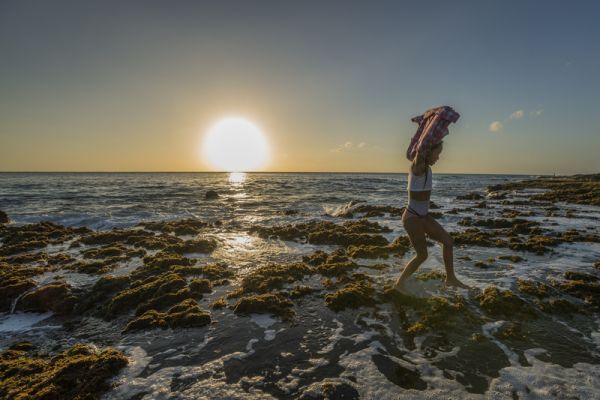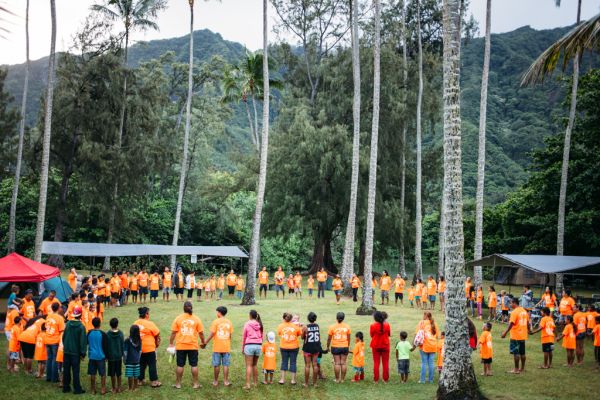 |
Canku Ota
|
 |
|
(Many Paths)
|
||
|
An Online Newsletter
Celebrating Native America
|
||
|
June 2016 - Volume 14
Number 6
|
||
|
|
||
|
What The Hawaiian
Language Revival Means For Conservation
|
||
|
by Kehau Springer -
Conservation International (CI) Hawai'i
|
||
In Hawai'i, we have a proverb that says "He ali'i ka 'aina, he kauwa ke kanaka": "The land is a chief, and man is its servant." In our worldview, there is no separation between nature and people; just as the land takes care of us, we need to take care of the land. This concept may seem simple, but years of cultural repression following the United States' takeover of Hawai'i jeopardized this connection — and we're only now beginning to restore it. Much of this recovery is due to the resurgence of the Hawaiian language. Not many people know that the Kingdom of Hawai'i was illegally overthrown in 1893. Three years later, the Hawaiian language was outlawed in schools, with children harshly punished and teachers losing their jobs if they disobeyed this law. In addition, parents could not converse with their children in public in Hawaiian. This was an ironic twist of fate for a kingdom that, when it was recognized by the major European powers as an independent state in 1843, was the most literate nation in the world.
Despite foreign and missionary influences, displacement off ancestral lands, and death and disease that left only 12,245 pure Native Hawaiians in 1959, our language and traditions survived thanks to ancestors who practiced in hiding. Now we are rediscovering a historical treasury of Hawaiian-language newspapers that documented daily life, stories, songs, chants, historical accounts, resource management techniques and many other topics through the lens of our ancestors. I was born in 1982, only four years after Hawaiian became an official language in Hawai'i alongside English. I did not learn Hawaiian until I was 13 years old, and did not become fluent until college. Once I learned my mother tongue, many things began to reveal themselves to me. I was able to understand the meaning behind place names, which often describe characteristics of that landscape or the resources found there. For example, Kiholo, a place found in the North Kona region of Hawai'i Island, has a few different meanings. Kiholo is a type of large wooden fishhook traditionally used to catch large fish; it also can refer to a large fish net. Another meaning refers to a plentiful amount of water flow. This should sound familiar to all who have been to Kiholo; the landscape is scattered with subterranean ponds that empty groundwater into the ocean each day. As I began to understand Hawaiian place names, these connections became clearer, and it led me to think about how land and oceans were managed and cared for. This was only the beginning of my journey to seek out respected elders and practitioners who continued these traditions. Over the years I've absorbed as much knowledge as I could from them, as well as watched how they turn their observations into management decisions. For example, Conservation International (CI) Hawai'i has worked with non-profit to protect and enhance the cultural and natural landscape of the Kiholo Bay area through collaborative management with the people living there. (Learn more in the video below.) Today there are many Native Hawaiian scholars and traditional practitioners of fishing, farming, ocean navigation, medicine, song, dance and language who have documented the rejuvenation of these arts into our daily lives and consciousness. It is now common for our people to refer to the Hawaiian lunar and seasonal calendars and know what moon phase we are in. Some Hawaiians can even tell you what types of plants and fish should be harvested during a certain moon phase according to its function and purpose. The balance of these interactions between the atmosphere, earth, oceans and our people has long governed our holistic and sustainable lifestyle. Our traditional kapu (resource management) system, which included a death sentence for rule-breakers, is much different from today's management system that gives everyone the right and privilege to fish without holding them accountable for over-consumptive actions.
In my work with CI Hawai'i, I am continuing on my journey of discovery and perpetuation of Hawaiian traditional resource management practices. Over the last five years, I've helped Native Hawaiian fishing communities identify, develop and promote sustainable and cultural fishing and resource management practices to achieve ?aina momona (abundance) and seafood security. We know that the most effective resource management changes come from actions at the individual and family level. This is why CI Hawai'i has supported the lawai'a 'ohana camp program since 2010, holding "fish camps" for Hawaiian children and families to perpetuate these sustainable fishing traditions. After attending a lawai'a 'ohana camp held in Kahana on O'ahu in 2013, we were inspired by the young leaders of this community and their passion for their land, oceans and stewardship efforts. Building on this relationship in Kahana, there was a shared interest in:
With this information, we hope to build a case study showing the role that local people can — and must — play in making decisions that affect the natural areas they depend upon every day. What we learn could then be shared in Hawai'i and with other indigenous communities around the globe. "I ka 'olelo no ke ola, I ka 'olelo no ka make." This Hawaiian proverb translates to: "In the Hawaiian language we find the life of our race, without it we shall perish." For this reason, I choose to speak only in Hawaiian to my 18-month-old son. When he eventually goes to school, I know he'll learn all about science and other modern tools; however, teaching him his ancestral language will set a foundation for him that will inform his view of the world. Kehau Springer is the coastal community capacity development advisor for Conservation International Hawai'i. |
|||||||
|
|
|
|
||
|
|
||
| Canku Ota is a free Newsletter celebrating Native America, its traditions and accomplishments . We do not provide subscriber or visitor names to anyone. Some articles presented in Canku Ota may contain copyright material. We have received appropriate permissions for republishing any articles. Material appearing here is distributed without profit or monetary gain to those who have expressed an interest. This is in accordance with Title 17 U.S.C. Section 107. | ||
|
Canku Ota is a copyright ©
2000 - 2016 of Vicki Williams Barry and Paul Barry.
|
||
 |
 |
|
|
The "Canku
Ota - A Newsletter Celebrating Native America" web site and
its design is the
|
||
|
Copyright ©
1999 - 2016 of Paul C. Barry.
|
||
|
All Rights Reserved.
|
||


